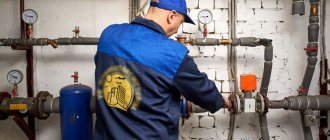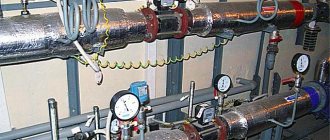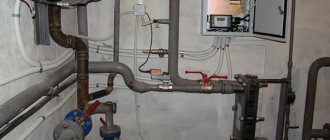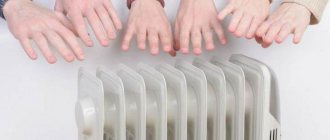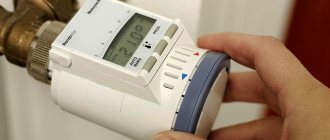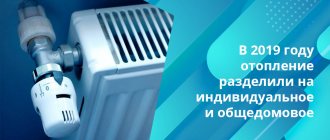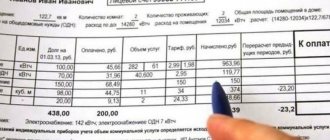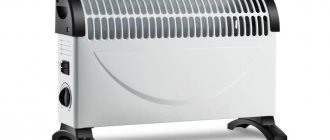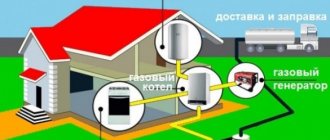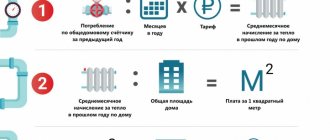The process of accounting for the consumption of utility resources must comply with the law. For these purposes, communal heat meters are installed in an apartment building, which provide reliable monitoring and recording of readings. Installation of ODPU is a mandatory procedure performed in compliance with current rules. There are reasons to avoid placing a common flow meter.
Who is responsible for the communal heat meter in an apartment building?
We will consider the question of who should install a common house meter in an apartment building later, and now we will find out who undertakes to change, repair and otherwise maintain the meter. The answer is simple - the meter is common property, and accordingly, responsibility for its maintenance and further operation lies with the management organization on whose balance sheet the house is located. The same applies to repairs and verification.
You must understand that the management organization is not directly involved in the installation or maintenance of meters. Its task is to allocate finances and order the services of professionals working in specialized companies.
ORDER A SERVICE FROM ACCREDITED COMPANIES
Types of heat meters
The function of the meter is to record the incoming heat and send the results to the energy supplier.
The operating principle of the registration units is almost the same for all types.
Device functions:
- a flow meter built into the supply circuit and a temperature meter provide information to the computing electronic device;
- the processor calculates the amount of supplied thermal energy and displays the result on the monitor.
The functions of a common house heat meter include transmitting information via GSM mobile communications or via the Internet to the energy supplier on duty.
Tachometer counter
Used in residential buildings and small public buildings. The device operates on small-diameter heating mains and is designed to account for energy resources in a small volume. The device does not connect to the mains, operates reliably and is inexpensive.
Depending on the type of moving element, tachometer counters are divided into types:
- single-jet, where the entire flow of liquid passes through the impeller;
- multi-jet, in which the water jet is divided into 2-3 streams in front of the blade compartment.
The device of the second structure is popular because it reduces the formation of nonlinear waves and increases the clarity of readings.
Tachometer coolant meter
Depending on the interaction with the liquid, there are counting mechanisms:
- land vehicles;
- wet.
The first type works longer due to the absence of unfavorable factors and is used for measuring hot water. The passing flow rotates the blades, and the counter receives information about the number of rotations of the impeller. The indicator in the form of a roller scales the readings using a mechanical gearbox and displays the result on the display.
In dry-propelled devices, the blades and the counting module interact using a magnetic field.
Vortex counter
Vortex flow meter for the heating system of an apartment building
The second most popular measuring device is installed on a straight section of the main line. It operates on the principle of the appearance of vortices behind an obstacle in the path of water flow. A vortex common house heat meter is installed on a horizontal or vertical pipe, the length of which is not significant.
The device must be installed on a line with a diameter of 20 – 300 mm. The flow compartment contains a triangle-shaped prism, a magnet and an electrode. Energy consumption is taken into account due to its movement along a vortex path, the liquid pressure affects the value of the readings.
In front of the common house heat meter, you need to install a filter to purify the water from accidentally ingressed impurities - this way the device will show the exact value and will last longer.
The vortex counter does not respond to the presence of rust elements in the liquid, but is sensitive to impurities, additives and dirt.
Electromagnetic counter
An electromagnetic meter that records the amount of coolant.
The flow meter operates on the principle of the emergence of an electric current in the coolant when it moves in a magnetic field - the feature of electromagnetic induction is used. The volume of consumption of the electrically conductive carrier, the average speed and voltage of the medium are interconnected, different potentials arise at the cathode and anode.
Electromagnetic devices calculate:
- the amount of thermal power and energy based on information about the volume of energy carrier and its consumption;
- temperature on the return and forward sections of the line with registration of changes in the heat capacity of the liquid as the indicator at the outlet and inlet decreases.
Electromagnetic meters are sensitive to operating conditions and installation method, since small currents appear. Poor-quality joining of wires causes resistance in the contacts and increases the error in the indicators. Despite their sensitivity, electrical appliances are stable; they are installed in single-circuit and double-circuit heating systems.
Regular maintenance and repairs are required; over time, the inside of the meter becomes coated, which distorts the amount of heat consumed. A filter is placed in front of the recorder so that rust and impurities do not force you to pay for excess energy.
Ultrasonic counter
Ultrasonic coolant metering device
The principle lies in the speed of passage of the ultrasonic wave from the emitter to the special signal receiver. The value depends on the flow rate of the coolant. On the pipeline, the source and receiver of the wave are installed opposite each other. The travel time between elements is directly proportional to the speed of the water. ODPU of thermal energy measures the flow of energy in the pipe based on the signal flow time.
A metering device based on an ultrasonic water flow meter has low resistance to the coolant. It operates in conditions of purified liquid, therefore it requires filters in front of the insertion area. If there are impurities in the water or bubbles appear, the readings are read with a large error. Ultrasonic meters are damaged by a layer of scale inside the device.
The devices are installed in their own houses, apartments or rebuilt high-rise buildings, where new communications have been laid or old ones have been replaced. In other cases, heat meters will fail or show inaccurate information.
Ultrasonic meters more often than other types fail due to poor water quality in urban heating mains.
How much does a communal heating meter cost?
The answer to the question of how much a common house heat meter costs,
may well shock many city residents and more. Many believe that such a meter is no different from an apartment meter, and accordingly, it should cost either the same or slightly more. However, the cost of a general metering device is usually orders of magnitude higher than that of an apartment meter.
The average price of a communal heat energy meter is about 60 thousand rubles. The figure is very approximate, since the cost depends on several factors, including the specific model and manufacturer. In any case, saving on its purchase is not recommended. This is fraught not only with a high error, and with it an increased payment for energy resources, but also with the occurrence of accidents. This is practically impossible if a good device is installed.
It is noteworthy that residents have several ways to pay for meter installation. First of all, this is a one-time payment if the entire amount is available. Only this option is available to legal entities ordering the installation of a meter. Installment plans for up to 60 months are also available, with the amount repaid in equal monthly installments. There is also a third option - repaying the amount from the capital repair fund. This is possible if the installation of a common house meter is included in the list of works as part of the overhaul.
How much does it cost to install or replace a common house heat meter?
You must understand that the price of the heat meter itself is only a small part of the amount that needs to be spent on turnkey installation. The full price includes the following costs:
- development and further approval of the project;
- purchase of a heat meter, sensors and flow meters;
- purchase of auxiliary materials for installation;
- direct installation of a common house appliance;
- commissioning and commissioning.
In total, taking into account all the points listed above, the complete installation of a common building coolant meter can range from 180 to 250 thousand rubles. Here again, everything depends on the specific house. In some cases, it takes even more to develop and implement a project.
Who installs communal heat meters?
According to Federal Law No. 261-FZ of November 23, 2009 “On energy saving and increasing energy efficiency, and on introducing amendments to certain legislative acts of the Russian Federation,” all consumed energy resources must be accounted for. This is precisely why communal metering devices are installed in apartment buildings. But what if the apartment building still doesn't have a meter? We know who exactly is responsible and must install the communal heating meter
.
In accordance with the Federal Law mentioned above, the responsibility for installing a metering device for an apartment building lies on the shoulders of the apartment owners. According to the government decree, residents must coordinate their efforts and jointly select a company that will sell the equipment and a contractor who will install the communal meter.
On the other hand, from July 1, 2012 onwards, there is no thermal energy meter in an apartment building; the resource supply organization is obliged to take responsibility for its installation. She must also organize the design and installation work.
Types of heat meters
There are quite a lot of models, they differ not only in appearance and technical characteristics. Experts often classify devices according to their operating principle.
To understand all the small details, it is worth considering each type of equipment and highlighting both the positive and negative aspects.
Vortex heat meters
This type of device is very popular; to install it in an apartment, there must be a straight section of pipe. As soon as the liquid has passed through the device, a special sensor detects the vortices that arose during the process.
When installing the device, a filter must be installed in front of it; it is designed to purify the water from possible impurities. Without additional devices it is impossible to talk about accuracy and high-quality work; this point is worth paying attention to first of all.
Mechanical
The device will be in demand in apartments where thermal energy is consumed minimally, the positive aspects are expressed in the following:
- Simplicity of the fastening process.
- Unpretentiousness to the environment.
- Low price.
During work, it is necessary to provide protection from scale and iron particles; for this, a filter is installed. If the coolant is too dirty, then over time the unit will fail and will need to be replaced with a new one. At the moment of blockage, the supply of heated water decreases noticeably; if measurements are taken, the pressure will become several times worse.
Ultrasonic
Experts advise implementing such modern models only in the main lines of new buildings; during operation, the device emits an ultrasonic signal that passes through water. There must be no impurities or other foreign particles in the liquid, otherwise there can be no talk about the accuracy of the measurement.
Special requirements are also imposed on the pipeline; there should be no accumulation of rust or other deposits inside. If these nuances are not provided for, one of the following problems will arise:
- The heat meter will overestimate consumption readings.
- A crash will occur.
- There may be interruptions in operation.
Since fluid clogs can often be found in central heating, modern models are much more likely to break down.
Electromagnetic meters
Experts immediately note the dependence of devices on quality maintenance and proper installation, otherwise they will not function for a long time. The process is based on recording small currents; they are created at the moment the coolant passes through a magnetic field.
Inflated readings of thermal energy consumption often occur due to deposits and plaque on parts; this must be constantly monitored. The water should not contain iron particles or impurities that interfere with the process, otherwise the readings will certainly be distorted.
Installation procedure
Installation of a common house heat energy meter is a sequential and complex process. First of all, a meeting of the owners of the apartment building is held. This is a mandatory condition, which, moreover, is the basis for further installation. In most cases, the initiator of such a meeting is the management company. If the house is managed by a homeowners association, residential complex or housing cooperative, the meeting is held at the request of the owners based on 10% of their signatures.
Next steps:
- Issuance by the heat supply organization of technical specifications for the installation of a common house meter.
- Development of an installation project and preparation of an estimate by the design organization, taking into account the selected device model and installation location.
- Coordination of the prepared project with the resource supply company, which previously issued the technical specifications.
- Purchase of a heat energy meter approved by the project, which must have a verification stamp.
- Installation work and commissioning of the common house meter, after which the whole process comes to its logical conclusion.
So now you know who should pay for installation
electricity meter, and who should do this anyway. This knowledge will definitely raise your level of household literacy. As for the meters themselves, be sure to buy them from a reputable place. For example, RosSchet provides a wide range of relatively inexpensive metering devices for household needs.
Common house meters: pros and cons
One of the main advantages of installing heat energy consumption meters is cost savings.
Before installing them, it is recommended to check the condition of the engineering systems of the entire house, repair pipes, insulate the facade of the building, glaze all the windows of the building and make sure that the entrance door closes tightly. All these measures will help avoid heat leaks.
The purchase and installation of equipment is paid for by the owners of the building. A small number of apartments in a building means high costs for each family. Further maintenance and possible repairs of heat meters also fall on the shoulders of homeowners.
If all technical requirements for servicing metering equipment are met, electricity costs are reduced by 30%, which leads to a full payback for the installation of a heat meter in 3 years.
